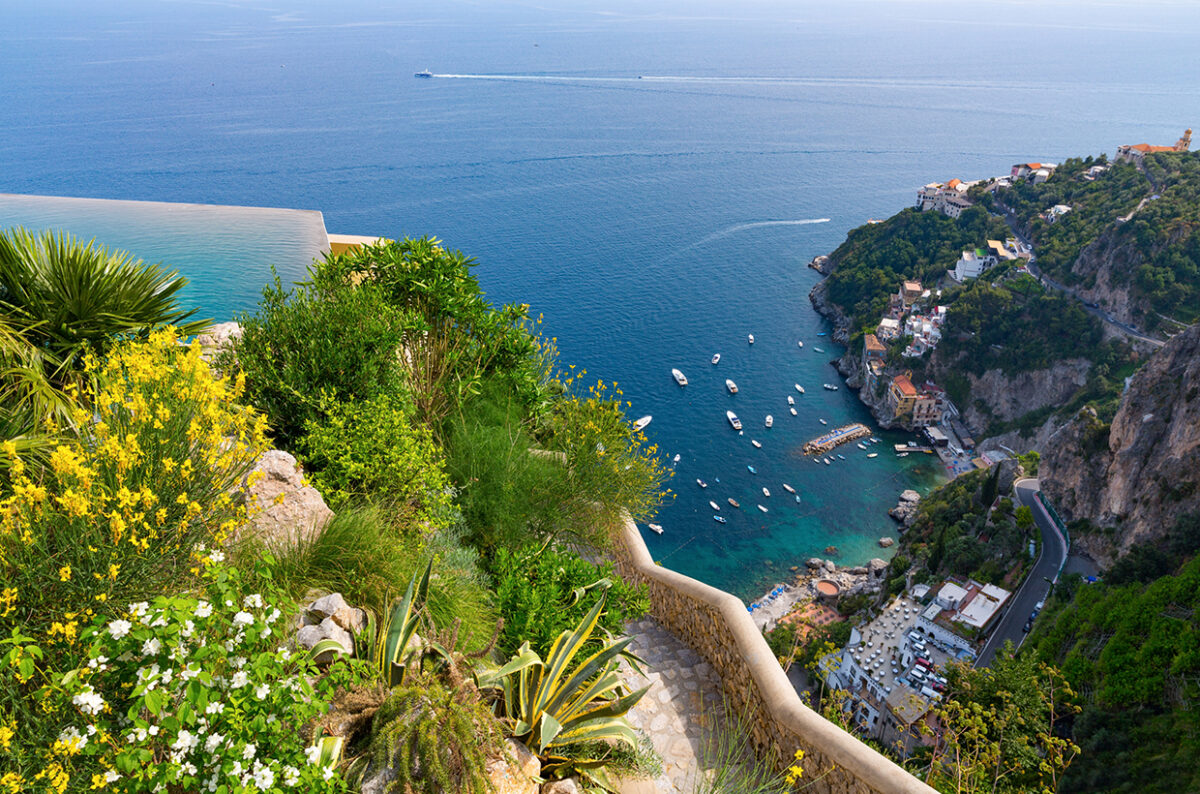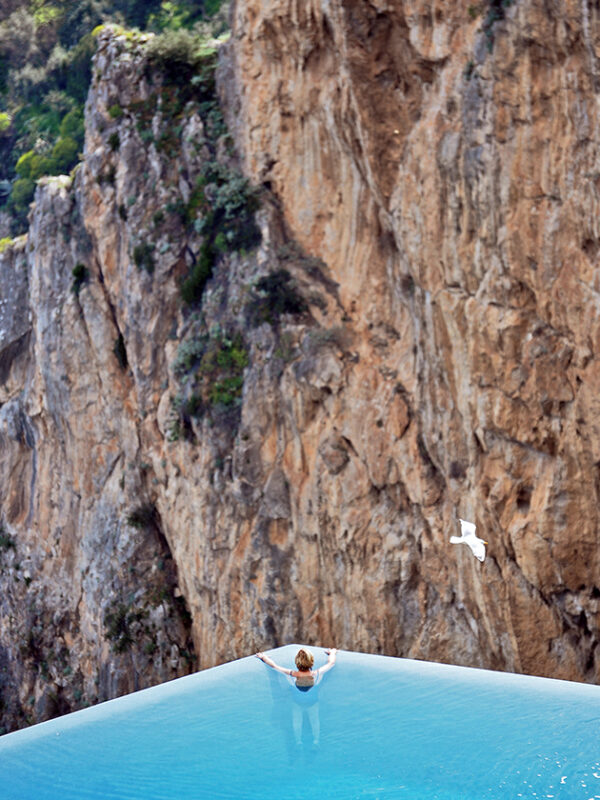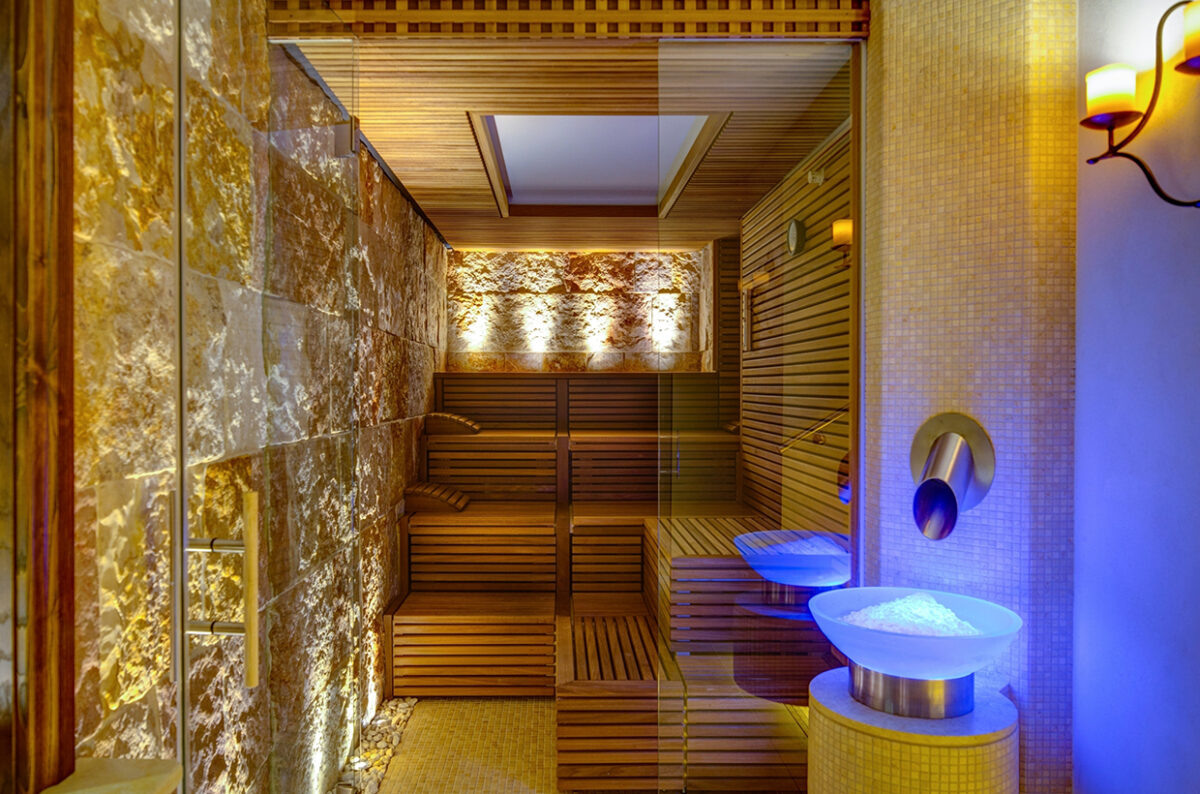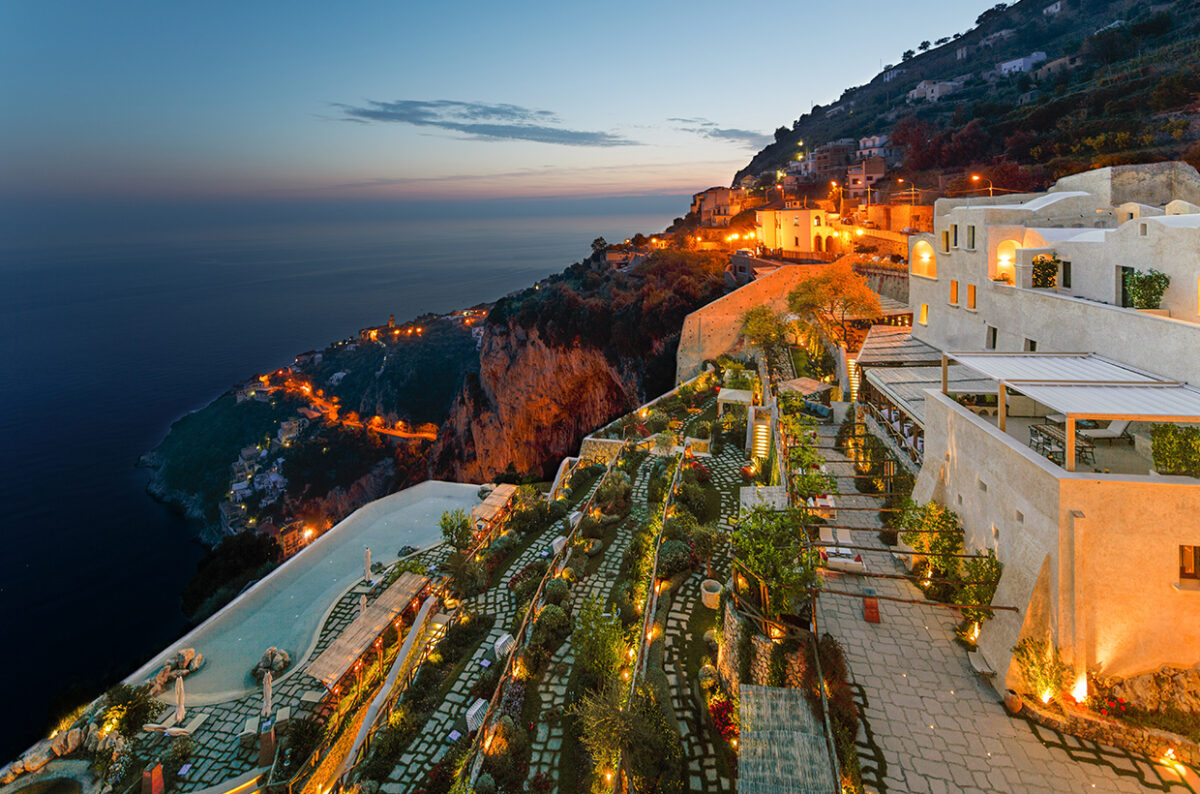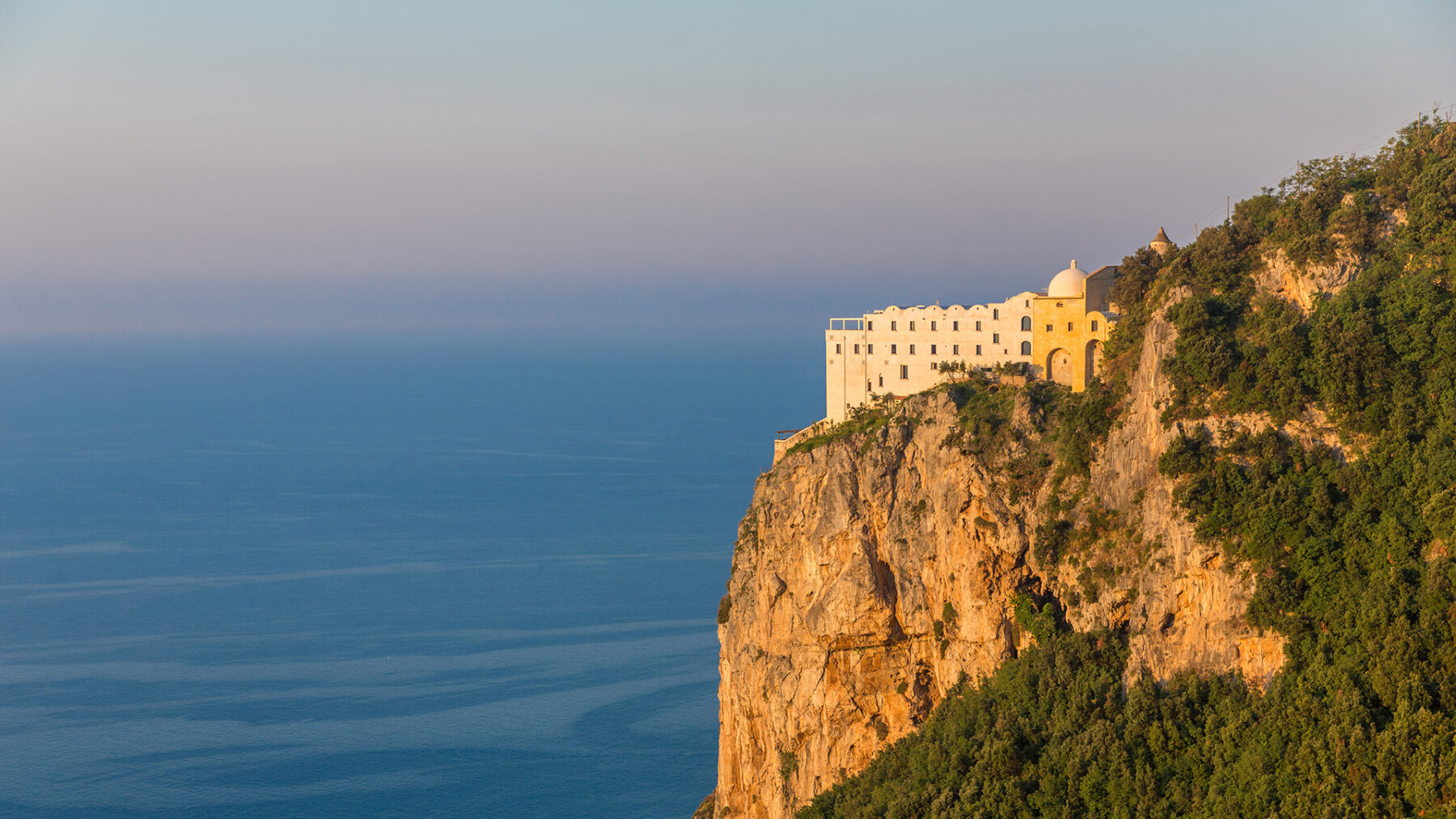That´s Amore! by . | 2nd September, 2022 | Travel
Anyone who has ever driven along the Amalfi Coast can relate to that tingly feeling: the happiness that sets in the moment your gaze travels across the steep cliffs, those pine trees, bending down like sculptures towards the deep blue Mediterranean Sea. Discover this area by boat – and you may actually fall in love. That’s how the beautiful story of a grieving lady from America and the Monastero Santa Rosa Hotel & Spa began…
Enchanting – that’s what it’s like to arrive at the Monastero Santa Rosa hotel. The magic begins with a glass of ice cold lemonade and a breathtaking view. Standing on the balcony of the former monastery, my view travels down. I see scented lemon trees, magnificent olive trees…
…a magical garden, blooming pink bougainvillea and romantic pathways that lead downwards across four steep terraces, culminating at the pool. And all of this framed by the deep blue Mediterranean Sea. After an 80-minute drive from the airport in Naples, we stop at the inconspicuous, almost hidden entrance – one that guests have been known to drive right past. My arrival is announced with a loud toll of a bell, just like back in the 17th century when nuns still lived here and welcomed their visitors to the monastery. After entering the hotel, I am immediately handed a refreshing drink and invited to step out onto the small balcony across from the reception desk to take in the view.
And what a spectacle it is! I see tiny boats drawing white lines across the deep blue sea as they cross back and forth between Amalfi, Positano and the isle of Capri. Below me, sea gulls glide in the air, circling the magnificent property proudly, as if claiming the Monastero Santa Rosa Hotel & Spa as their own. All of this beauty must have captivated the American Bianca Sharma in much the same way 22 years ago when the hotel’s actual owner first set eyes on these extraordinary premises high above the Mediterranean.
After the sudden and premature death of her husband, the former Montessori nursery teacher and mother of two grown sons went on a trip with her family and friends to the beautiful Amalfi Coast in search of consolation. “I spotted the monastery from the sea and was intrigued by the stone structure that seemed to grow directly from the cliff,” Bianca Sharma said in an interview with U.S. trade magazine “Leaders.” “When I asked the boat captain about the structure, he told me it was a monastery and that it was for sale. Something strongly pulled me to want to learn more, and I returned to the U.S. with a dream of bringing this abandoned building to glory by creating a luxury hotel.”
“Prego, signora,” says the concierge, drawing me from my reverie and taking the empty glass from my hand. “May I show you to your room?” We walk together down the cool, dark covered walkways, past the nuns’ old confessional where guests are invited to leave feedback today. The bright terrace on the hotel’s top floor is just the place to watch the glorious sunset and enjoy a spectacular, 180-degree view across the Gulf of Salerno. The first thing I do when I get to my suite is open the windows – and I am relieved to see that I can enjoy the view over the gardens onto the wide expanse of sea here too.
When furnishing the 20 rooms and suites, Bianca Sharma took particular care to retain some of the building’s austere character. Warm mahogany wood combined with precious, light-hued textiles create a wonderfully harmonious effect in the former nuns’ quarters. And despite the monastic esthetic, guests want for absolutely nothing when it comes to coziness and comfort.
The 20 to 25-square-meter rooms – there are only a few suites, each with a private balcony, and only one with a 75-square-meter terrace – were created by combining two or more of the original nuns’ cells. And they feature every technical luxury you can imagine. Guests can enjoy listening to music or watch a movie, and there are even two screens for those who come equipped with their own media library.
Great attention to detail has clearly been paid to every part of the Monastero Santa Rosa, and guests see this wherever they look. Instead of a conventional Do not Disturb sign, the ones here are hand-painted on wood with a leather strap. On the front, they show a nun with her eyes closed, holding a finger to her lips. On the back there’s a scene of nuns straightening up a room. The restaurant menus are also decorated with lovely illustrations that depict, among other things, flying nuns with red umbrellas in their hands, tumbling into the garden from the top floor of the hotel.
As I’m unpacking my suitcase I notice the two little sfogliatelle (literally “lobster tails”) that have been placed in my room as a welcome treat – a delicious pastry made of phyllo dough, which was invented by the nuns of this very monastery. For years, they kept the recipe to themselves but today these delicate cream-filled pastries are known all over Italy. I take a bite and have to admit – they’re heavenly.
No wonder Bianca Sharma was so enamored of the old monastery because a lot of history has taken place within its thick walls. Built in 1680 by the Pandolfi family to provide accommodation for Dominican nuns, it became part of the existing Santa Maria di Grado church. In 1866, the monastery was deconsecrated by the Catholic Church and turned over to the municipality, but the remaining nuns were allowed to continue living there until 1912. A short time later, the building was discovered by the Sicilian hotelier Massimiliano Marcucci, who bought it and turned it into a hotel. The last member of Marcucci’s family died in 1998 and a distant relative living in northern Italy inherited the property.
By the time Sharma noticed it, the Monastero Santa Rosa had fallen into disrepair. After taking a good look at the state of the property, her financial advisor tried to discourage her from buying it: There was no infrastructure to speak of, the former monastery had only three bathrooms serving all of the rooms and really, did she as an American want to get involved in a business venture in southern Italy? But Bianca Sharma wouldn’t be dissuaded and refused to give up her vision.
Bureaucratic hurdles and time-consuming renovations caused repeated delays, and so the Monastero Santa Rosa Hotel & Spa didn’t open in its current form until 11 years later. Since then, and in a relatively short space of time, it has won many significant awards – a fact the owner is proud of, and rightly so. In 2019, the Monastero Santa Rosa was ranked “Top Hotel in Italy” by Condé Nast Traveler and in 2020 it was designated “Hotel of the Year” at the European Hotel Awards.
This year, celebrated chef Alfonso Crescenzo joined the team, and the Il Refettorio restaurant, which boasts a Michelin star, draws many tourists from the area, not just guests of the hotel.
Sitting at the bar with hotel director Ferdinando Alfano, who kindly invited me to join him for a pre-dinner drink, I ask whether Bianca Sharma is still very much involved with the running of her hotel in Italy. “Oh, absolutely!,” he exclaims. “I have a meeting with her in Positano tomorrow, we have some important matters to discuss.”
Bianca Sharma loves coming here in the spring best of all because she likes to be around to prepare the hotel for the coming season. She still commutes back and forth between the Amalfi Coast and her two residences in the U.S., one in Colorado and the other in South Carolina. And instead of talking to journalists about her hotel, she lets it speak for it- self. Her son Nathan is managing partner and helps his mother run the hotel.
Dressed in elegant evening attire, the other guests slowly gather on the terrace for a sundowner. Soon, they will head to the restaurant for dinner. Later this evening, I too will be given a taste of what the kitchen has to offer. I rise very early the next day and take the elevator to the garden level, from where I walk down some steps to the pool just as the sun is coming up. The other guests are presumably still sleeping and there’s no one else around, but a pool attendant nevertheless brings me an iced coffee.
I appreciate the luxury of having this small corner of the property to myself. I’m tempted to hang onto the side of the heated pool for hours, gazing over the edge and admiring the rocky outcrop. I watch in silence as the first rays of the sun begin to sparkle on the water. In the afternoon, after a delectable visit to the spa, which has a steam bath, sauna and jacuzzi, I relax for a few moments by the crowded pool where I can’t help but notice that the mood is entirely different now, as are the colors of nature all around me.
I decide to go down to the pool every morning for the rest of my stay, make a ritual of watching the sunrise on my own. And every morning, iced coffee automatically appears. I only leave the magical clifftop castle twice. The first time, I take the hotel shuttle into the nearby town of Amalfi, but don’t stay very long because I find it hard to ignore the bustling crowds after the exquisitely peaceful atmosphere I’ve become accustomed to at the hotel. My visit to Ravello, just a 20-minute drive away, is far more enjoyable, and I spent several hours admiring Villa Cimbrone and Villa Rufolo and enjoying the magnificent gardens. On the way back to the hotel, I catch sight of the Monastero Santa Rosa clinging to the clifftop high above me. Pointing to it my driver says, the respect evident in his voice: “Signora Sharma is very much admired here!”

